
Denver Art Museum

Audio By Carbonatix
Whether you’re traveling by foot in downtown Denver or by car on the interstate, you don’t have to wait long before spotting an interesting sculpture or a mural that brightens the side of a building. Denver is home to many artistic works that beautify the city; read about ten of the city’s most famous public works of art below.
“Big Sweep”
Created in 2006 by the late New York pop artist Claes Oldenburg and his second wife, Coosje van Bruggen, “Big Sweep” perfectly represents the artist’s goal of turning the mundane into the extraordinary. The sculpture displays a yellow and red broom frozen in a sweeping motion as it tosses crumpled bits of paper into a massive blue dustpan. Placed outside of the Denver Art Museum, “Big Sweep” was inspired by the plains and winds of Colorado.
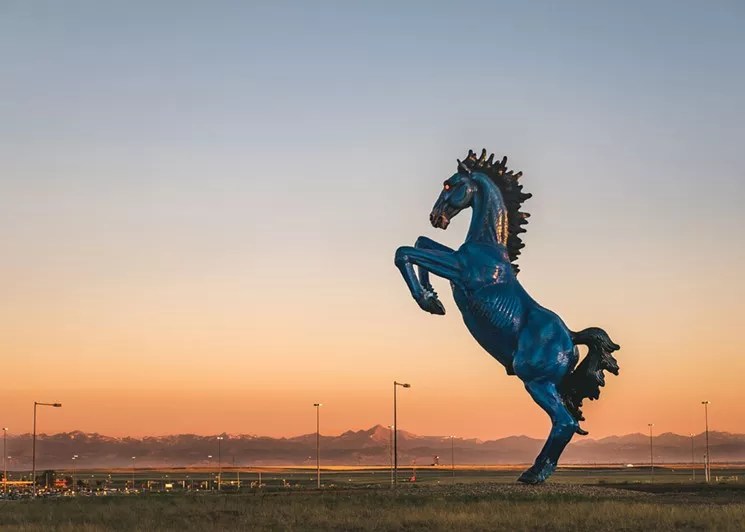
“Blucifer” welcomes visitors outside of the Denver International Airport.
Marvin Anani
“Blucifer”
Officially titled “Mustang” – but better known to Denver residents as “Blucifer” – the 32-foot-tall, supposedly cursed stallion that greets visitors and bids them farewell outside of Denver International Airport is easily the state’s most well-known work of art. The sculpture’s glossy fiberglass blue body and glowing red eyes are a fierce welcome to the Mile High City, and the lore surrounding the sculpture – yes, the artist behind the work, Luis Jiménez, did die while working on the massive piece in 2004 – makes it all the more unique. The sculpture was completed by Jiménez’s sons after his death, and debuted in 2008.
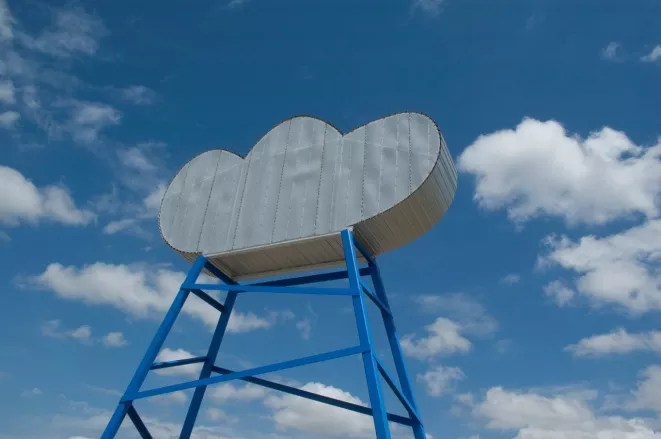
“Cloudscape,” by Christopher Lavery.
Denver Public Art
“Cloudscape”
Consisting of three large clouds displayed on blue steel stands, “Cloudscape” was designed by sculptor Christopher Lavery in 2010 for its original home along Peña Boulevard. Lavery imagined drivers seeing the clouds from afar, allowing their imagination to roam before seeing the sculptures up close. The sculpture was moved in 2014 to its current location, outside of the Children’s Museum of Denver. Thirteen years after it was made, the installation still captures the beauty of the Colorado sky – especially at night, when the clouds light up with colors that represent the sunrise and sunset.
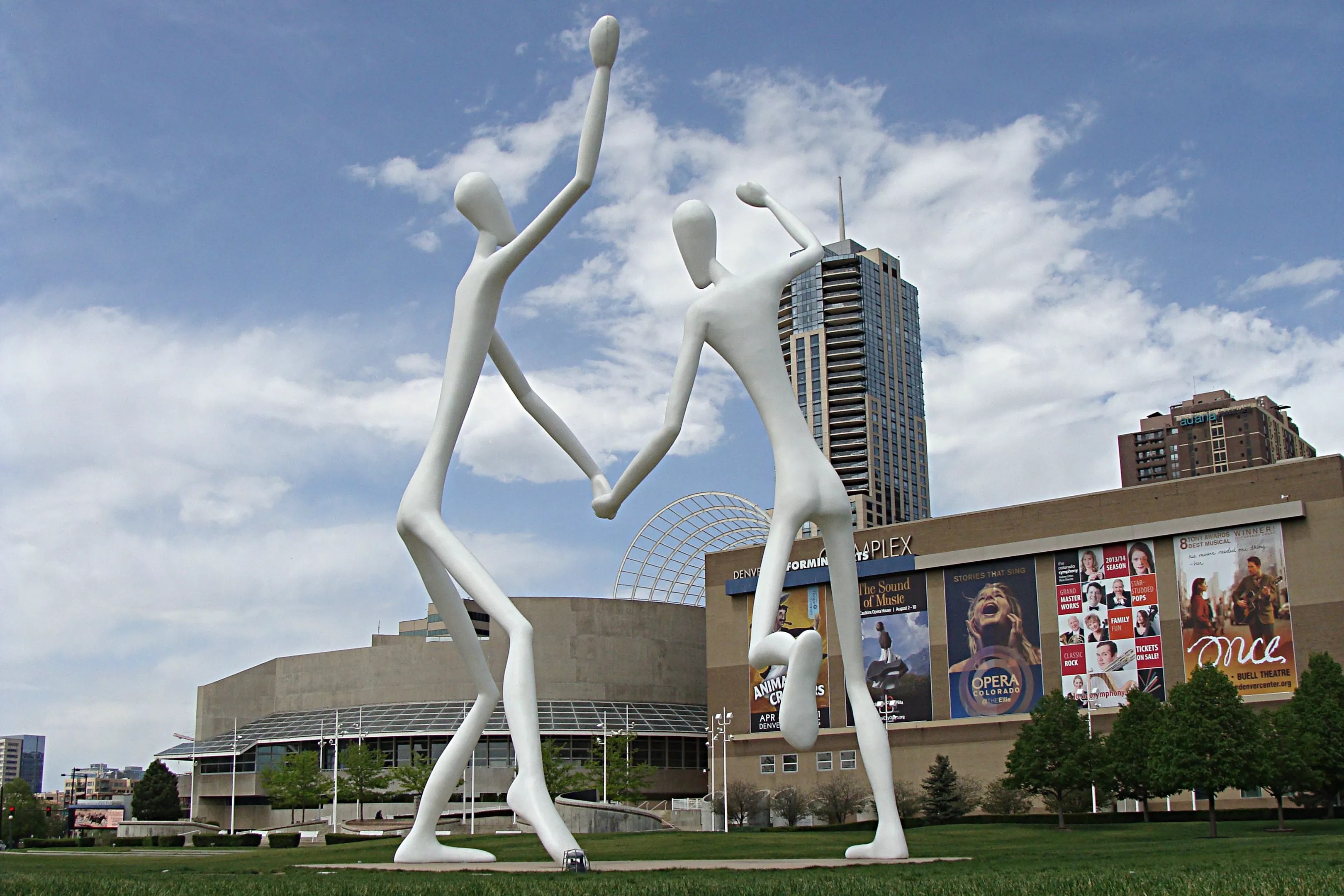
“Dancers” caught in motion outside of Denver’s Performing Arts Center.
denver.org
“Dancers”
A sixty-foot-tall sculpture that somehow effortlessly captures the flow of movement in stone, Jonathan Borofsky’s “Dancers” was the first installation created for the then-new Sculpture Park outside of the Denver Performing Arts Complex in 2003. Twenty years later, people still gather around the sculpture for the park’s festivals, concerts and more.

“I See What You Mean” features a giant, curious blue bear.
Marvin Anani
“I See What You Mean”
The nosy, forty-foot blue bear permanently peeking into the Colorado Convention Center is a fun, impossible-to-miss addition to a traditionally bland corporate space. Created by local artist Lawrence Argent, who passed away in 2017, the sculpture, titled “I See What You Mean” but more affectionately known as “the Blue Bear,” has been curiously peering into the convention center since its installation in 2005. The playful bear was inspired by the flow of ideas that are often sparked in such convention centers, as well as Argent’s own curiosity about the hustle and bustle within.
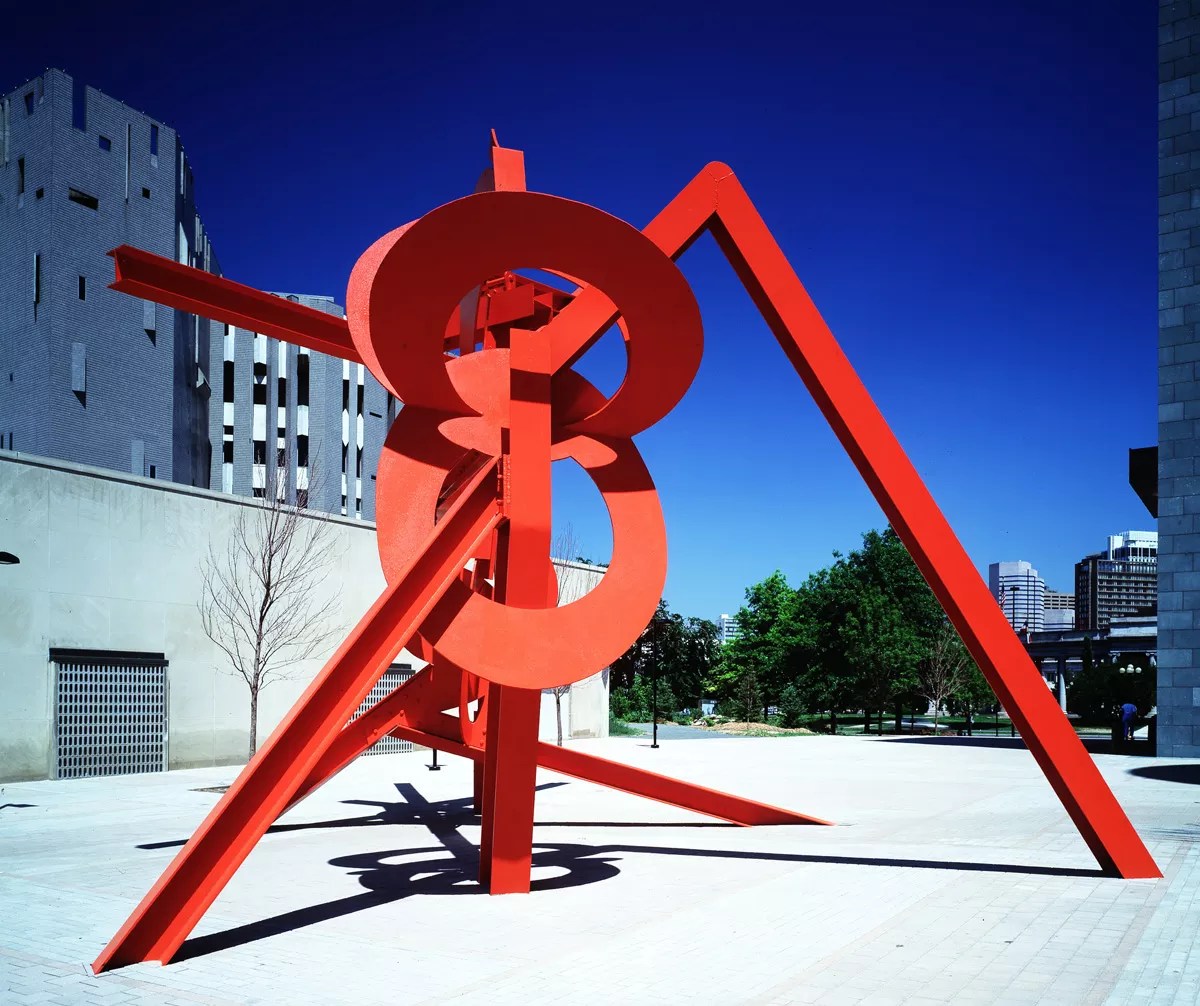
“Lao Tzu,” in Acoma Plaza.
Denver Art Museum
“Lao Tzu”
“Lao Tzu,” the massive expressionist sculpture located in Acoma Plaza near the Denver Art Museum, is a doodle brought to life. Mark di Suvero created the installation in 1991 straight from one of his many drawings; he decided against making the 3-D models sculptors traditionally use when preparing a design. The piece’s bright color is meant to contrast with the blue Colorado sky, and its jutting design is meant to draw the viewer’s attention to the space around it. Di Suvero named the sculpture after the philosopher believed to be the founder of Taoism.

“Man, Woman,” by Fernando Botero
Denver Public Art
“Man, Woman”
Colombian artist Fernando Botero‘s style is so unique that it was named for him. “Man, Woman” is a perfect example of Boterismo; the two-piece installation that welcomes audience members and musicians to the Denver Performing Arts Complex was installed in 1998. Botero’s work is known to comment on societal norms with sculptures that depict human and animal forms with uneven proportions and large, exaggerated volumes. Crafted from bronze, the figures are expressionless witnesses to the stream of theater-goers who have waded around them for more than two decades.
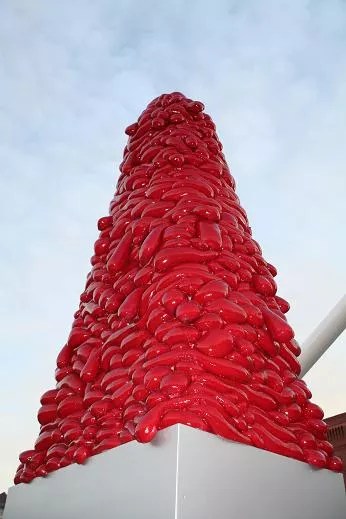
“National Velvet,” near the 16th Street Pedestrian Bridge.
Denver Public Art
“National Velvet”
A tower of what looks like melted red candies, the playfully odd “National Velvet” stands sentry near the 16th Street Pedestrian Bridge. Created by Denver visual artist John McEnroe in 2008, the sculpture has had mixed reviews, but has generated a lot of conversation; the city even had a block party in its honor in 2014. The piece is made from aluminum and fiberglass, and the bulbous, unusually shaped blobs were created by coating sand-filled nylon in resin and then draining the sand, leaving the shells behind.

“Scottish Angus Cow and Calf,” by Dan Ostermiller.
Courtesy Denver Art Museum
“Scottish Angus Cow and Calf”
Created by Wyoming-born artist Dan Ostermiller, “Scottish Angus Cow and Calf” depicts a bronze cow resting in the grass next to her awkward, spindly-legged calf. The piece was commissioned by Colorado ranch owner Leo Hindery, who adored his Scottish Angus cows and wanted to commemorate the large, lovable animals. Hindery promised to donate the sculpture if he ever sold his property and made good on his word, gifting it to the Denver Art Museum in 2006. The work captures the body language of the cows that Ostermiller observed to create the piece, mimicking how they behaved in his presence while in their natural habitat.
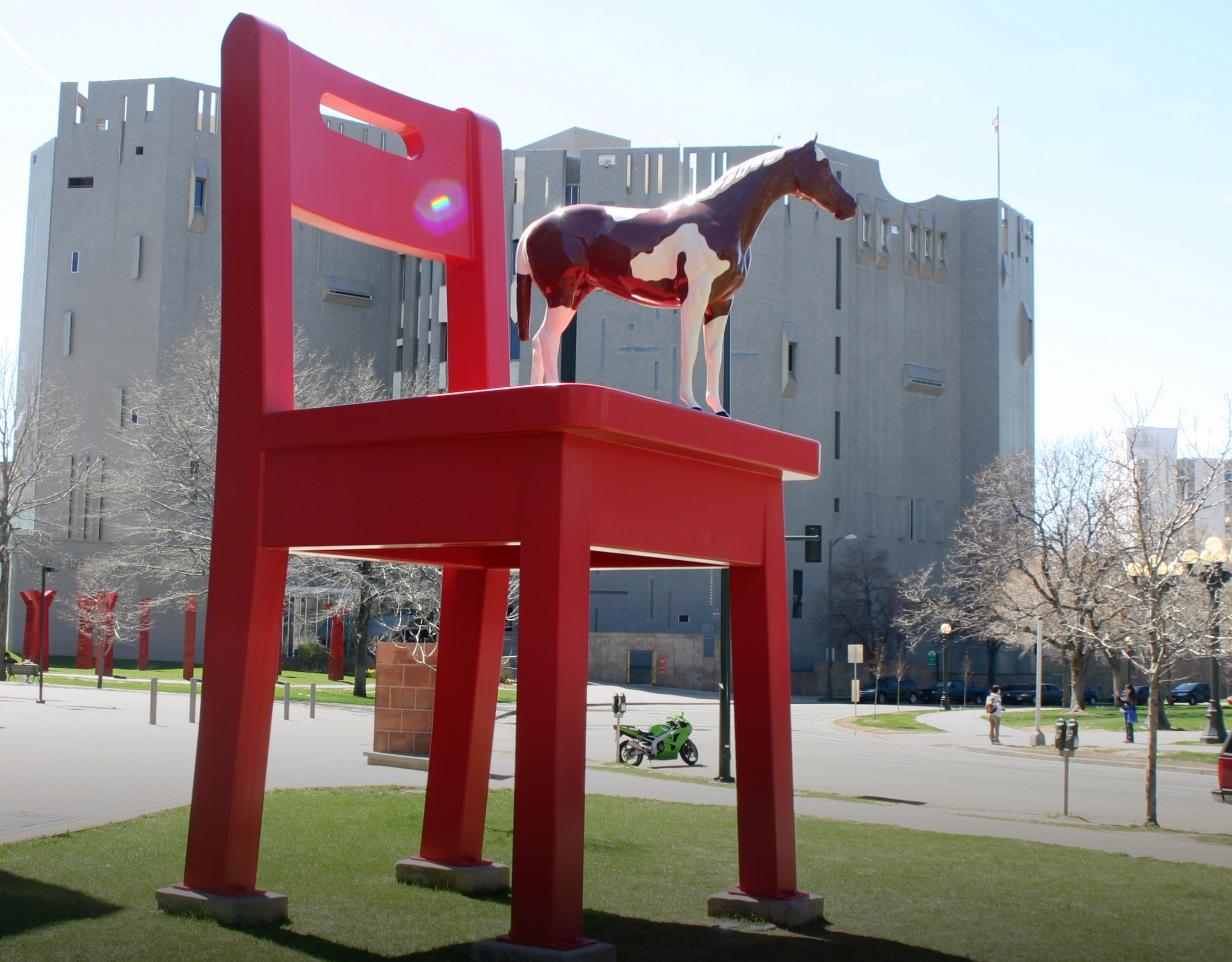
“The Yearling,” located outside of Central Denver’s Public Library.
Denver Arts & Venues
“The Yearling”
“The Yearling” comprises a 21-foot, cherry-colored steel chair topped by a six-foot fiberglass pinto pony, and sits proudly outside of Denver’s Central Public Library. Sculptor Donald Lipski originally created the work for a school in New York City, but had to scrap his plans after parents’ complaints. The late Nancy Tieken, a curator at the Denver Art Museum, fell in love with the piece after seeing it at Doris Freedman Plaza in Central Park. Tieken eventually bought it as a gift for the city in 1998, and “The Yearling” found its permanent residence, where it has welcomed children to the public library for more than 25 years.